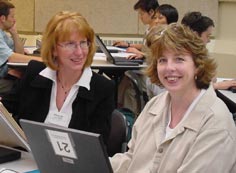 |
|
||||||||

|
A Scaffold for Writing Language Objectives adapted from a handout by Tara Fortune Writing specific language objectives is an important part of curriculum development for content-based instruction. These objectives point to the grammatical structures and vocabulary students need to carry out a particular communicative function. Below we highlight a formula developed by Tara Fortune to write language objectives that identify three necessary linguistic components--functions, structures and vocabulary. The sample language objectives below correspond to the following classroom activities. As you read through the classroom tasks, consider the implications these tasks have for language use--what language do students need to carry out the tasks? Imagine that a high school Spanish class is engaged in a lesson about the geography of Spain. The first task is an information gap activity. Pairs of students have maps of Spain--Student A's map has some items and Student B's map has other items. For example, Student A's map shows the Pyrenees mountains in the north of Spain and the Mediterranean Sea to the east of the country, whereas Student B's map shows the Sierra Nevada in the south and the Bay of Biscay in the north. The students need to ask and respond to questions to complete their respective maps. After their maps are complete, students are to share personal opinions and preferences related to geographic features (e.g., I like mountains; I don't like the ocean, etc.). Finally, the teacher shows a video or slides of major Spanish geographic features and in a large group the class compares and contrasts geographic features of Spain to those of the U.S. The Formula: Students will use X (language structure) to do Y (functions) with Z (words/word groups). Below, the three language categories (grammatical structures, functions, vocabulary) appear along with examples under each that correspond to the activities described above. For example, in order to complete their respective maps, Students A & B need prepositions to identify the location of geographic features. This is the first step of the process—teachers need to think through the various structures, functions and vocabulary needed to carry out the activities and list them in corresponding categories.
With the formula:
Activity 1: Identification
INSTRUCTIONS: Identify the X, Y and Z sections in the objectives below. Click on the section of text until the color matches the X, Y or Z box. Language Objectives - Content Obligatory:
Language Objectives - Content Compatible:
|
||||||||